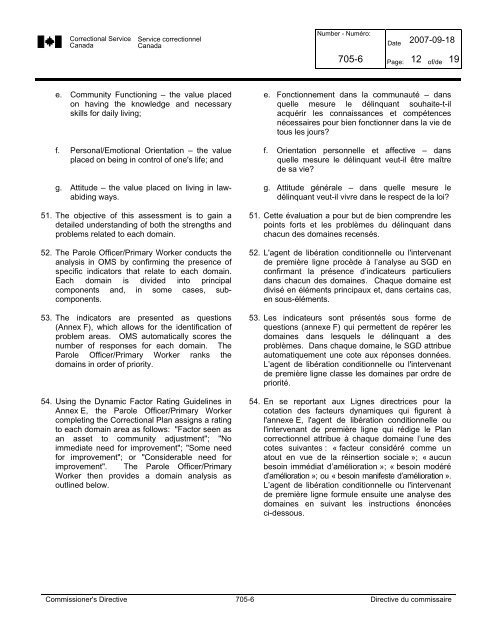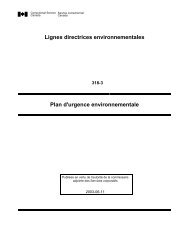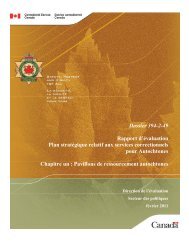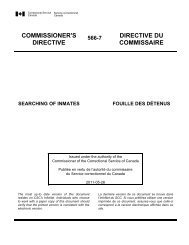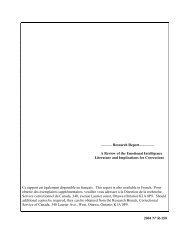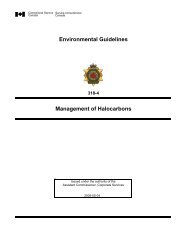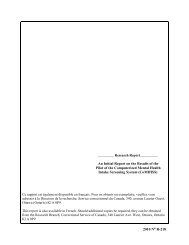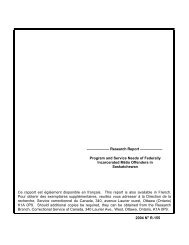CD 705-6 - Correctional Planning and Criminal Profile - Service ...
CD 705-6 - Correctional Planning and Criminal Profile - Service ...
CD 705-6 - Correctional Planning and Criminal Profile - Service ...
You also want an ePaper? Increase the reach of your titles
YUMPU automatically turns print PDFs into web optimized ePapers that Google loves.
<strong>Correctional</strong> <strong>Service</strong> <strong>Service</strong> correctionnel<br />
Canada Canada<br />
e. Community Functioning – the value placed<br />
on having the knowledge <strong>and</strong> necessary<br />
skills for daily living;<br />
f. Personal/Emotional Orientation – the value<br />
placed on being in control of one's life; <strong>and</strong><br />
g. Attitude – the value placed on living in lawabiding<br />
ways.<br />
51. The objective of this assessment is to gain a<br />
detailed underst<strong>and</strong>ing of both the strengths <strong>and</strong><br />
problems related to each domain.<br />
52. The Parole Officer/Primary Worker conducts the<br />
analysis in OMS by confirming the presence of<br />
specific indicators that relate to each domain.<br />
Each domain is divided into principal<br />
components <strong>and</strong>, in some cases, subcomponents.<br />
53. The indicators are presented as questions<br />
(Annex F), which allows for the identification of<br />
problem areas. OMS automatically scores the<br />
number of responses for each domain. The<br />
Parole Officer/Primary Worker ranks the<br />
domains in order of priority.<br />
54. Using the Dynamic Factor Rating Guidelines in<br />
Annex E, the Parole Officer/Primary Worker<br />
completing the <strong>Correctional</strong> Plan assigns a rating<br />
to each domain area as follows: "Factor seen as<br />
an asset to community adjustment"; "No<br />
immediate need for improvement"; "Some need<br />
for improvement"; or "Considerable need for<br />
improvement". The Parole Officer/Primary<br />
Worker then provides a domain analysis as<br />
outlined below.<br />
Number - Numéro:<br />
Date<br />
2007-09-18<br />
<strong>705</strong>-6 Page: 12 of/de 19<br />
e. Fonctionnement dans la communauté – dans<br />
quelle mesure le délinquant souhaite-t-il<br />
acquérir les connaissances et compétences<br />
nécessaires pour bien fonctionner dans la vie de<br />
tous les jours?<br />
f. Orientation personnelle et affective – dans<br />
quelle mesure le délinquant veut-il être maître<br />
de sa vie?<br />
g. Attitude générale – dans quelle mesure le<br />
délinquant veut-il vivre dans le respect de la loi?<br />
51. Cette évaluation a pour but de bien comprendre les<br />
points forts et les problèmes du délinquant dans<br />
chacun des domaines recensés.<br />
52. L'agent de libération conditionnelle ou l'intervenant<br />
de première ligne procède à l’analyse au SGD en<br />
confirmant la présence d’indicateurs particuliers<br />
dans chacun des domaines. Chaque domaine est<br />
divisé en éléments principaux et, dans certains cas,<br />
en sous-éléments.<br />
53. Les indicateurs sont présentés sous forme de<br />
questions (annexe F) qui permettent de repérer les<br />
domaines dans lesquels le délinquant a des<br />
problèmes. Dans chaque domaine, le SGD attribue<br />
automatiquement une cote aux réponses données.<br />
L’agent de libération conditionnelle ou l'intervenant<br />
de première ligne classe les domaines par ordre de<br />
priorité.<br />
54. En se reportant aux Lignes directrices pour la<br />
cotation des facteurs dynamiques qui figurent à<br />
l'annexe E, l'agent de libération conditionnelle ou<br />
l'intervenant de première ligne qui rédige le Plan<br />
correctionnel attribue à chaque domaine l’une des<br />
cotes suivantes : « facteur considéré comme un<br />
atout en vue de la réinsertion sociale »; « aucun<br />
besoin immédiat d’amélioration »; « besoin modéré<br />
d’amélioration »; ou « besoin manifeste d’amélioration ».<br />
L’agent de libération conditionnelle ou l'intervenant<br />
de première ligne formule ensuite une analyse des<br />
domaines en suivant les instructions énoncées<br />
ci-dessous.<br />
Commissioner's Directive <strong>705</strong>-6 Directive du commissaire


